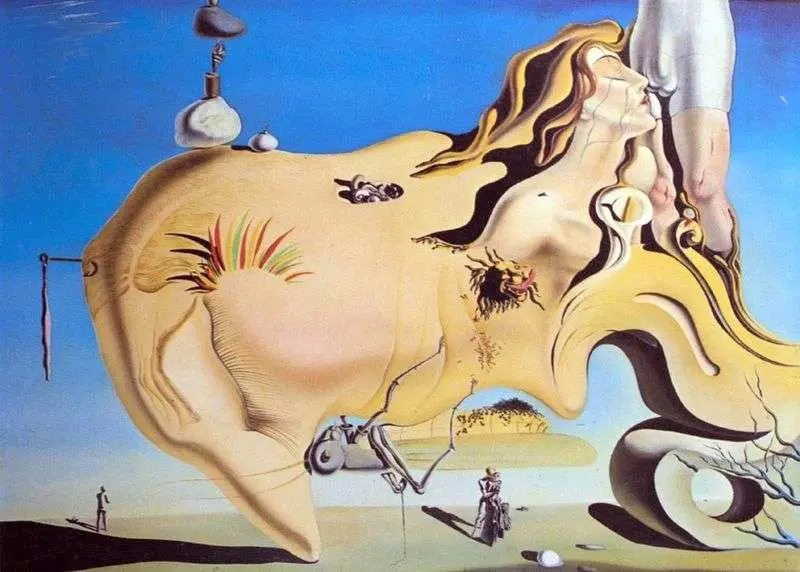Title of Artwork: “The Great Masturbator”

Artwork by Salvador Dali
Year Created 1929
Summary of The Great Masturbator
In his autobiographical work The Great Masturbator (1929), the artist explores his own sexual obsessions, worries, and fears. The painting’s focal point is a big amorphous shape that is a deformed self-portrait of the artist: Dali represents himself with his eyes closed and a large grasshopper placed on his mouth. Some of Dali’s other works, such as his masterpiece The Persistence of Memory, also feature self-portraits that are quite similar to this one (1931).
All About The Great Masturbator
Dali claims that he modelled his self-portrait after a natural outcropping in Cap de Creus, a coastal region of Catalonia. A part of Hieronymus Bosch’s The Garden of Earthly Delights (1510-1515) has been compared to the self-portrait by some experts; on the right side of the left panel, Bosch shows rocks, plants, and little creatures that resemble the profile with the prominent nose and long eyelashes.
The artist plays the role of “the great masturbator,” with a female figure emerging from the base of his neck to symbolise his unspoken libidinal urges. Dali’s future wife and creative inspiration, Gala Éluard, is named. Her upper body and mouth are juxtaposed with the lower half of a man’s body, which is cut off at the knees, but is still visible from the waist up.
While Gala was still married to Dail’s friend and fellow Surrealist poet Paul Éluard, he painted The Great Masturbator in late summer of 1929, when their relationship was only beginning. Both the precarious nature of their passion and the artist’s worry that Gala would use or consume him were depicted in the picture.
Gala is a polarising figure; her presence is both cherished and dreaded. She stands for the artist’s aversion to castration and female sexuality, but also the possibility of achieving spiritual and sexual freedom through this partnership.
The grasshopper represents Dali’s early-life phobia of insects and stands out as the most menacing feature in the picture. The insect in The Great Masturbator is called a locust in the poem that Dali composed to go along with the picture.
The grasshopper’s attachment to the lower part of the face, rather than the mouth, suggests that for Dali, the insect represented a fear of being consumed or sucked in.
The grasshopper, in this reading, represents Gala in a different way. Portrait of Paul Éluard, another work from the era, lends credence to this assertion (1929). Gala had already left Éluard by the time he had finished the portrait he had begun while she was still there.
The roaring lion, Dali’s profile portrait, and most notably, the grasshopper are all reminiscent of his masterpiece The Great Masturbator. Grasshopper probably means Gala is there, and it also represents Dali’s worries about adultery and what it means for their relationship.
Only the artist himself kept The Great Masturbator. His bequest stipulated that his picture be donated to Spain’s national collection, and it is now housed in Madrid’s Museo Reina Sofa.
Information Citations::
